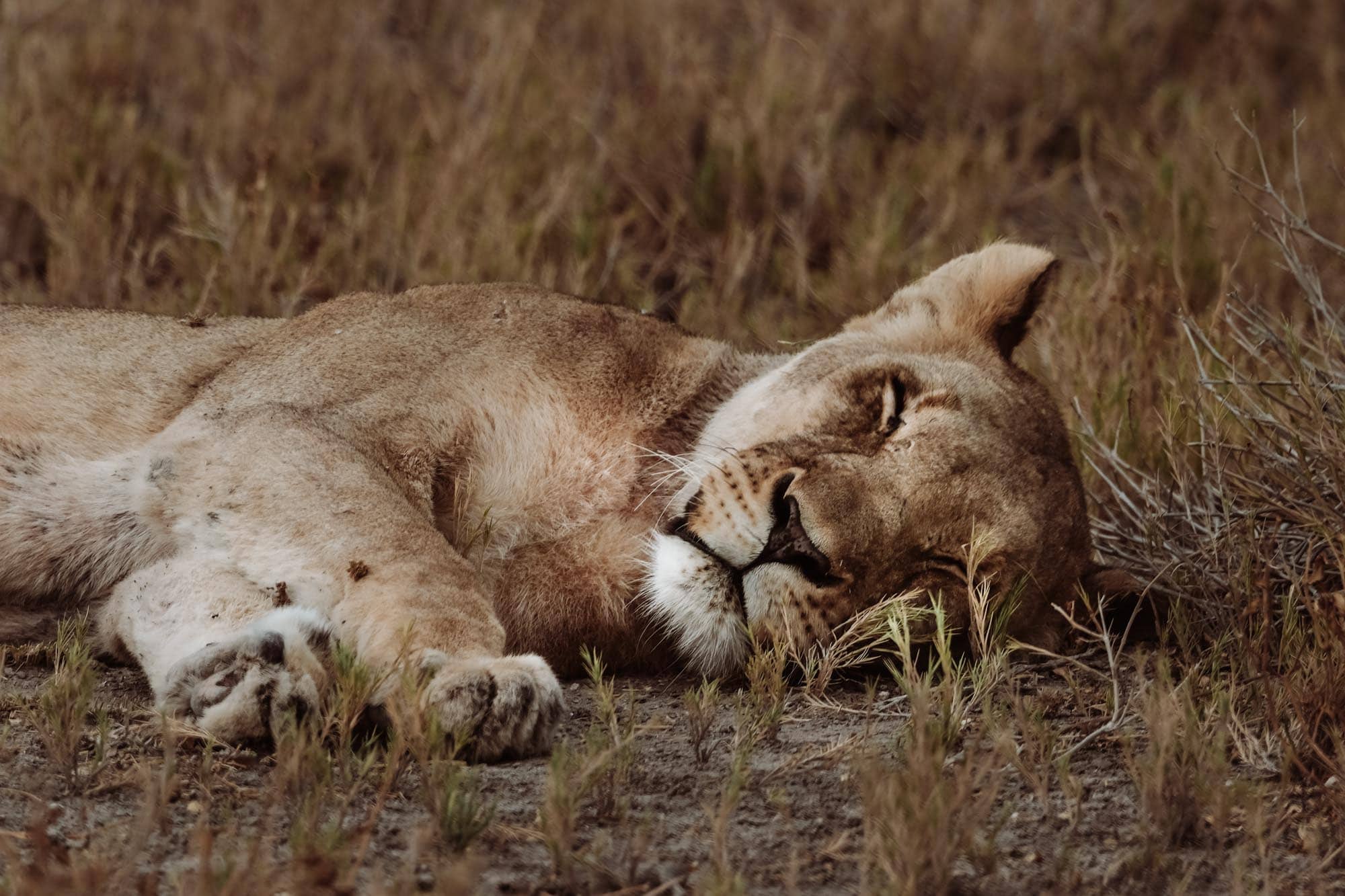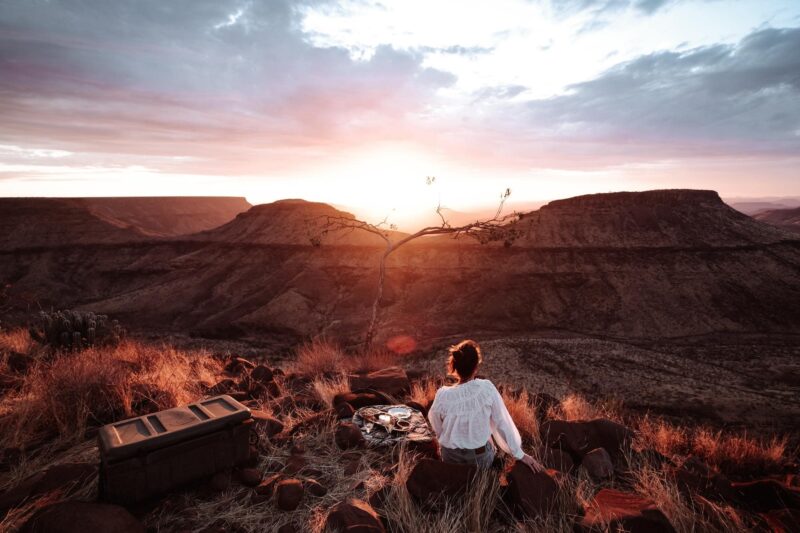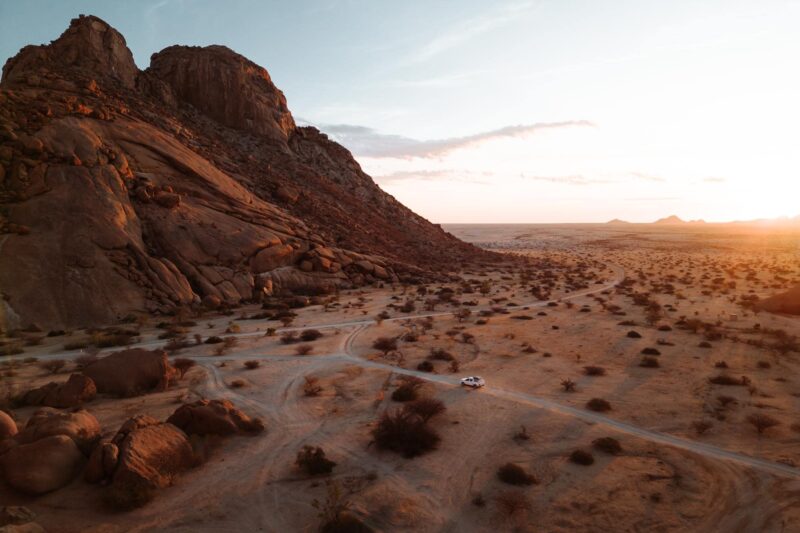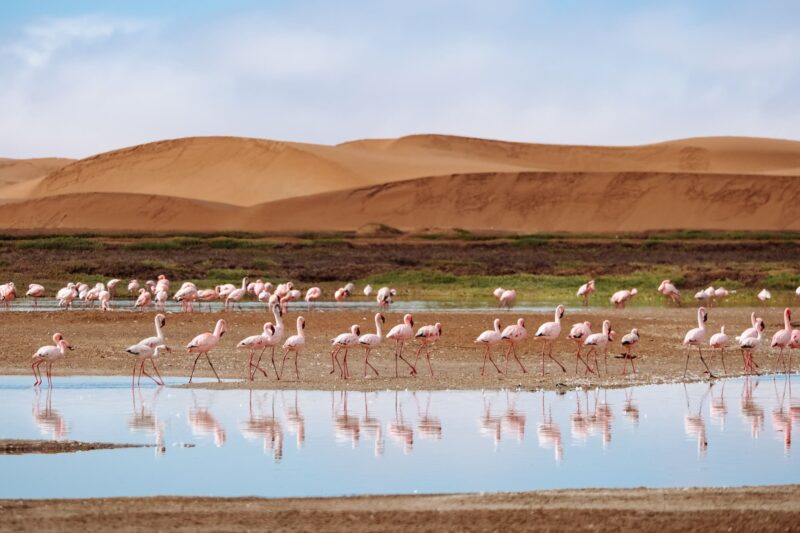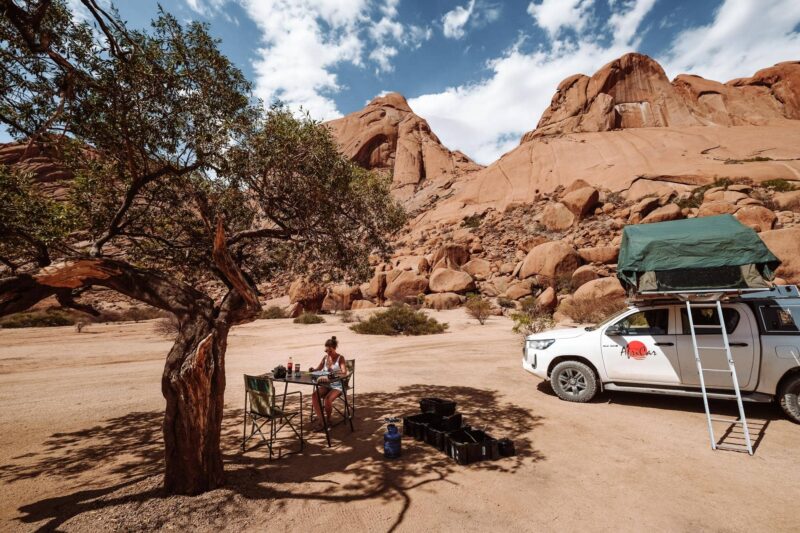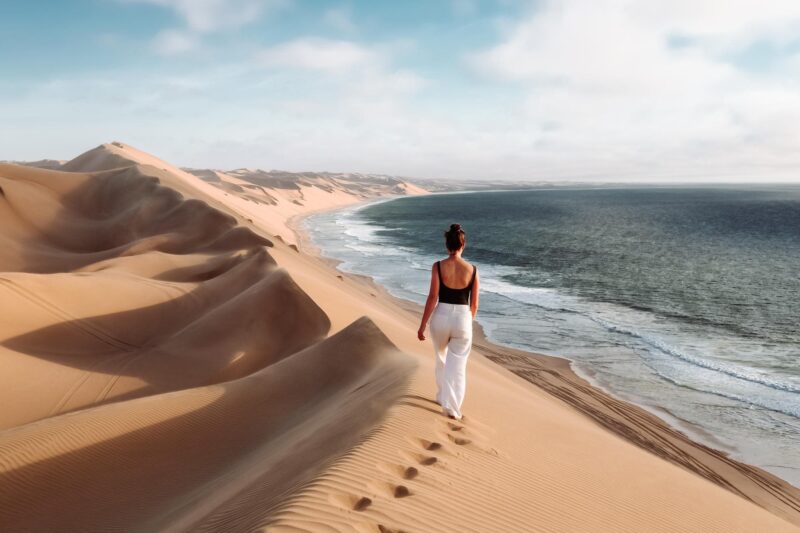A visit to Etosha National Park is a dream for anyone eager to witness the wilderness of Namibia. Etosha is quite small, making it best explored over multiple days. The landscape, mostly bare and expansive, surrounds a gigantic salt pan, creating the perfect setting for wildlife spotting. Spend several nights at one of the camps within the park to start your safaris early in the morning. At night, you’ll be awakened by the roar of lions and the trumpeting of elephants. A visit to Etosha National Park is undoubtedly one of the highlights of a journey through Namibia.
What Makes Etosha National Park So Unique?
Etosha National Park is renowned for its impressive array of wildlife and unique landscapes. Covering an area of over 22,000 square kilometers (8494 square miles), it’s one of the largest national parks in southern Africa. The park boasts numerous waterholes, the best spots for wildlife sightings. Animals gather here to drink, bathe, and, in the case of elephants, play. The Etosha Pan, a salt pan spanning approximately 5,000 square kilometers (1930 square miles), dominates much of the park. This salt pan is so vast that it’s visible from space. Thousands of years ago, the Etosha Pan was a large lake, but geological and climatic changes caused it to dry up, leaving behind the salt. Almost all year round, the salt pan remains dry, except during the rainy season when it may be covered with a layer of water, attracting large flocks of birds, including huge groups of flamingos.

Which Animals Live in Etosha National Park?
Etosha National Park is home to over 100 different mammal species, 340 bird species, and 110 reptile species. Below is a preview of the animals you may encounter in Etosha.
Lion, cheetah, leopard, jackal, hyena, meerkat, African wild dog, African wildcat, elephant, black and white rhinoceros, oryx, zebra, flamingo, hornbill, pangolin, giraffe, kudu, wildebeest, springbok, ostrich, and baboon.
Staying Overnight in Etosha National Park
For the ultimate experience in Etosha National Park, opt to stay overnight at one of the six camps within the park. Here, you can either camp with your 4×4 or book a cottage, allowing you to set out early into the park. Each camp in Etosha features a viewpoint overlooking a waterhole, often illuminated, offering the opportunity to admire thirsty animals even in the darkness. Especially in the evening, numerous animals come to drink. We witnessed two lions, a group of giraffes, five rhinoceroses with a baby, and springboks all drinking at the same waterhole. As you sleep in the heart of the park, you’ll hear the roar of lions and the trumpet of elephants from your bed—an incredible experience!
Each camp has a restaurant where you can enjoy breakfast and dinner, as well as a pool and a small shop. However, the selection is limited, so if you prefer to cook your own meals at the campsite, it’s better to do your shopping beforehand. Make sure to return to the camp before sunset, as the gates close then.
Overview of all camps in Etosha
- Okaukuejo Camp
- Halali Camp
- Namutoni Camp
- Dolomite Camp
- Olifantsrus Camp
- Onkoshi Camp
The Various Entrances of Etosha National Park
Etosha National Park has four different entrance gates. Which entrance you use depends entirely on your travel direction through Namibia, but most people travel within Etosha from west to east or vice versa. At the entrance, you’ll need to fill out a form and receive a slip of paper that you must keep safe because you’ll need to show it again when exiting the park. You pay the park entrance fee at the reception of one of the camps.
- Galton Gate – Western Entrance
- Anderson Gate – Southern Entrance
- Von Lindequist Gate – Eastern Entrance
- King Nehale Gate – Northern Entrance
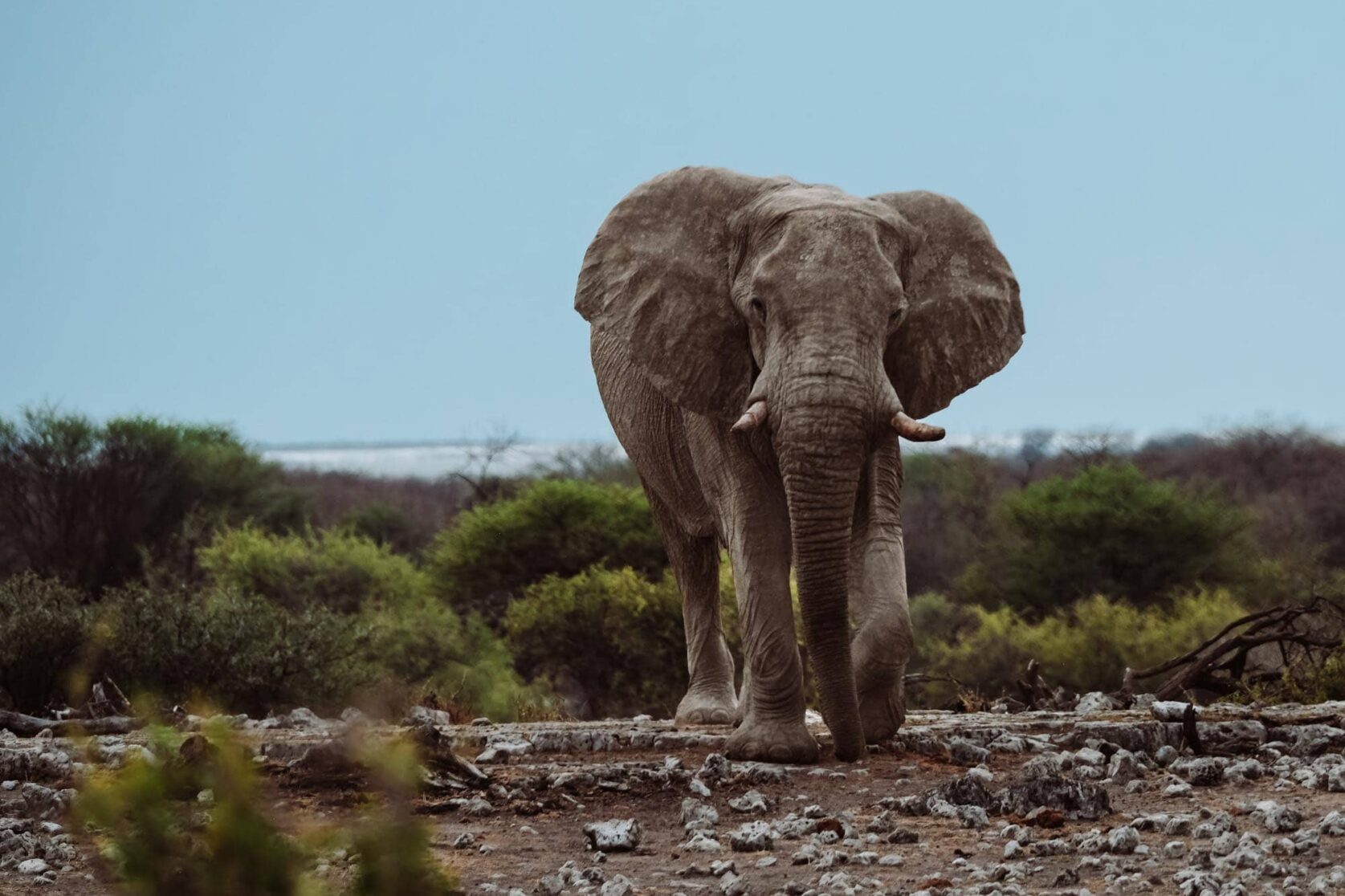
Our Visit to Etosha National Park
We visited Etosha during our fantastic road trip with Namibia Nomads, making a circuit around the country counterclockwise. This led us to enter Etosha National Park through the eastern entrance, Von Lindequist, and then camp for the first night at Namutoni. The following day, we drove through many side roads to the centrally located Halali camp for a quick lunch. We spent the second night at Okaukuejo camp in the west. After the second night, we drove in the early morning past several water holes and then exited the park via the Anderson Gate. If you’re traveling with Namibia Nomads, they handle all accommodations, so you just hop in the car and enjoy. If you’re organizing it yourself, you need to be early to reserve your accommodation.
What’s Better: Self-Drive or Game Drive?
You have the option to drive yourself through Etosha National Park or join an organized game drive. During a game drive, you ride in an open jeep with a guide through the park. The guide educates you about the animals living there, making it a completely different experience from a self-drive. In some parks, these jeeps can drive off-road, taking you to places inaccessible by your own car. This isn’t the case in Etosha. You always visit places you can access with your own vehicle. So, a game drive is mainly about enjoying the outdoors and learning interesting facts about the animals you encounter. You can book a game drive during check-in at one of the camps. We drove ourselves for three days in the park and did one morning game drive. It was a nice change from the self-drives, but it’s not a must if you’re traveling on a tighter budget because you see just as many animals on a self-drive.

Tips for a Self-Drive in Etosha National Park
Driving in Etosha National Park isn’t difficult. The roads are unpaved but generally well-maintained as they are wide and without significant elevation changes. However, the side roads, less traveled by cars, may have many potholes, especially during the rainy season between December and February. These routes take more time but are much more enjoyable than the main road. The maximum speed in Etosha is 60 km/h (37 mph). Always remain vigilant for crossing animals while driving. Particularly, springboks may get startled by cars and suddenly cross the road. The distances between camps in Etosha aren’t very large, so don’t drive too fast and take the side roads for a better chance of seeing wildlife and beautiful landscapes.
Important: You must never leave your car in Etosha National Park. Ensure all necessary items are kept inside your car. There is one exception where you can briefly leave the car, and that is at the Etosha Pan Lookout. This is a viewpoint situated in the middle of the salt pan. A truly unique spot! Need to use the restroom? Head to one of the camps or one of the fenced picnic areas.
What is the Best Time to Visit Etosha National Park?
You can visit Etosha National Park year-round. For the highest chance of spotting wildlife, the best time to visit is from May to October. This period falls during the winter and dry season. With no rainfall, many waterholes in the park become busy spots. Without leaves on trees and bushes, you’ll have better visibility of animals. Don’t worry if you plan to visit Etosha National Park outside these months; the chance of spotting wildlife is still high. We visited in November and crossed off a significant number of animals from our checklist. From December onwards, the landscape of Etosha becomes greener, which is beautiful but also makes spotting animals a bit trickier. The advantage of the summer months is that many babies are born, and there are many flamingos to see on the salt flats.
How Many Days in Etosha National Park?
Etosha National Park is a remarkable destination, so make sure you allocate sufficient time for it. We recommend planning at least two nights for Etosha. Planning more days is always beneficial, but we advise against fewer days as it’s truly too short.
9 Tips for Spotting Wildlife in Etosha National Park
While the scenery in Etosha is remarkable, most people visit for the wildlife. Here are our top tips for spotting animals.
#1 Go Just After Sunrise and Just Before Sunset
Animals are most active during sunrise and sunset. We encountered multiple large herds of elephants when we went for a short drive just before sunset. Eventually, they all converged, and at one point, there were about 70 elephants around us. Magical! These times are also ideal for spotting big cats. They tend to sleep during the day and hunt at night. You’re likely to spot them early in the morning or just before it gets dark at one of the many waterholes.
Tip: Make sure you leave the park or are within the gates of a camp before sunset. It’s prohibited to drive through the park in the dark. Opening and closing times of the gates are always displayed on the board at the reception of your camp.
#2 Download the App or Buy a Map of Etosha National Park
While spotting animals in Etosha, it’s fun to check off the ones you’ve seen. You can purchase a map of Etosha at the small shops in the camps. It contains a clear map of Etosha, information about the park, and photos of all the animals living there. You can also download the app of Etosha National Park, which includes the map of Etosha and information about the most common mammals living there. You can buy premium in the app for a few dollars, which gives you access to additional information per animal. For example, you can read about the locations in the park where lions are most frequently spotted each season, as well as interesting facts about their behavior and diet.
#3 Visit Waterholes as Much as Possible (Even at Night)
There are countless waterholes in Etosha National Park, some natural and others man-made. The map of Etosha shows all the waterholes, allowing you to see which ones are along your route. If there are no animals at the waterhole, it’s often worth waiting.
Every camp in Etosha National Park overlooks a waterhole. Take a seat on a bench, pour yourself a glass of wine, and enjoy watching the animals come to drink. Be sure to visit these waterholes at night too. The waterholes at the camps are illuminated, and many animals come to drink in the dark. The waterhole at Okaukuejo Camp, in particular, is a place where you can spot a lot of animals. It’s even considered the best place in Africa to spot the black rhinoceros. They come to drink here almost every evening of the year.
Tip: Bring mosquito repellent when you go to watch the waterholes at night because there can sometimes be many mosquitoes.
#4 Bring a Good Pair of Binoculars to Etosha National Park
A pair of binoculars is essential when visiting Etosha National Park. It makes spotting animals much easier than with the naked eye alone. We’ve spotted animals from a great distance using binoculars multiple times. Even when an animal is close by, it’s nice to study every detail through your binoculars. Unfortunately, binoculars aren’t cheap, but one of the most affordable yet good pairs is the 10×50 by National Geographic. You’ll certainly get a lot of enjoyment out of it throughout Namibia.
#5 Take as Many Side Roads as Possible
There’s one long main road in Etosha National Park with many smaller side roads branching off. It’s wise to spend as little time as possible on the main road and take as many side roads as you can. This is where you’ll find most of the waterholes and venture deeper into the park, increasing your chances of spotting wildlife.
#6 Turn Off Your Engine When Viewing Animals
When you spot an animal, you’ll probably stop for a while to admire it. Always turn off your engine so that you, other visitors, and the animals can enjoy peace and quiet.

#7 Keep an Eye on Other Vehicles
If you see cars stopped somewhere, there’s most likely an animal to see. Check the direction the binoculars are pointing, and spotting animals suddenly becomes much easier!
#8 Most Animals Rest Under Trees and Bushes During the Day
When the sun is high in the sky, it’s best to search under trees and bushes. Animals like lions and leopards prefer to rest in the shade during warm afternoons.
#9 Patience is a Virtue
Spotting animals is always unpredictable, so patience is key. We once waited for a long time at an empty waterhole until suddenly, in the distance, a group of 30 elephants came charging towards us. They rushed into the water, made a lot of noise, and started bathing. This was definitely the highlight of our visit to Etosha National Park.
